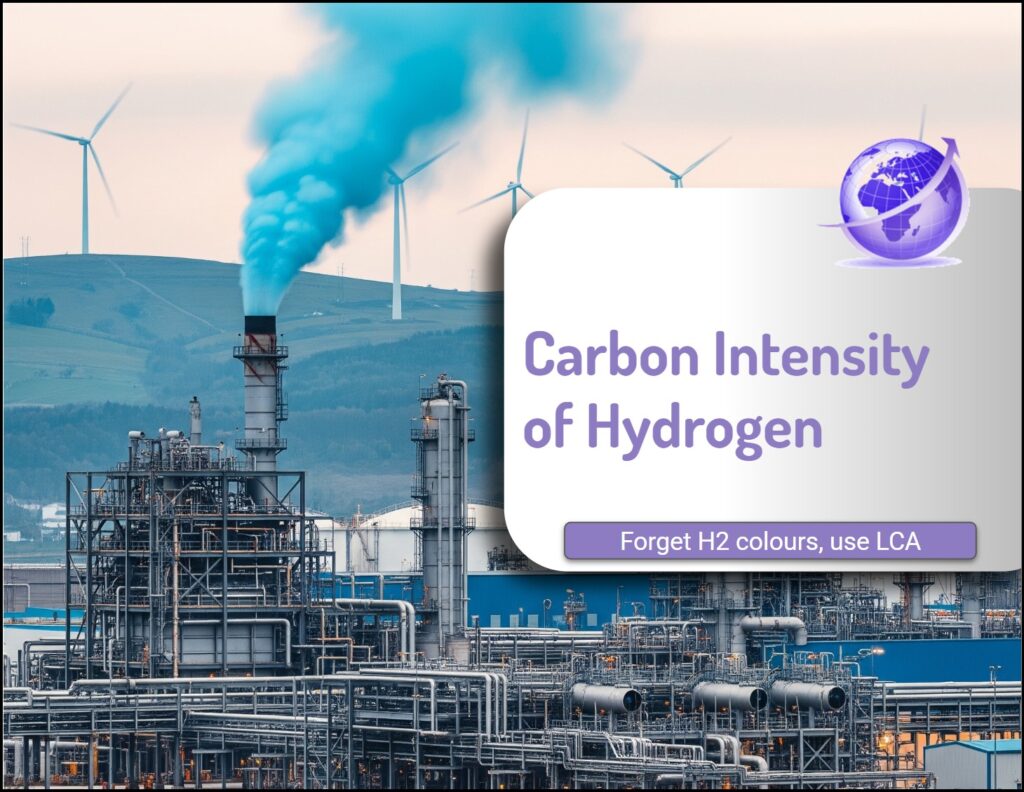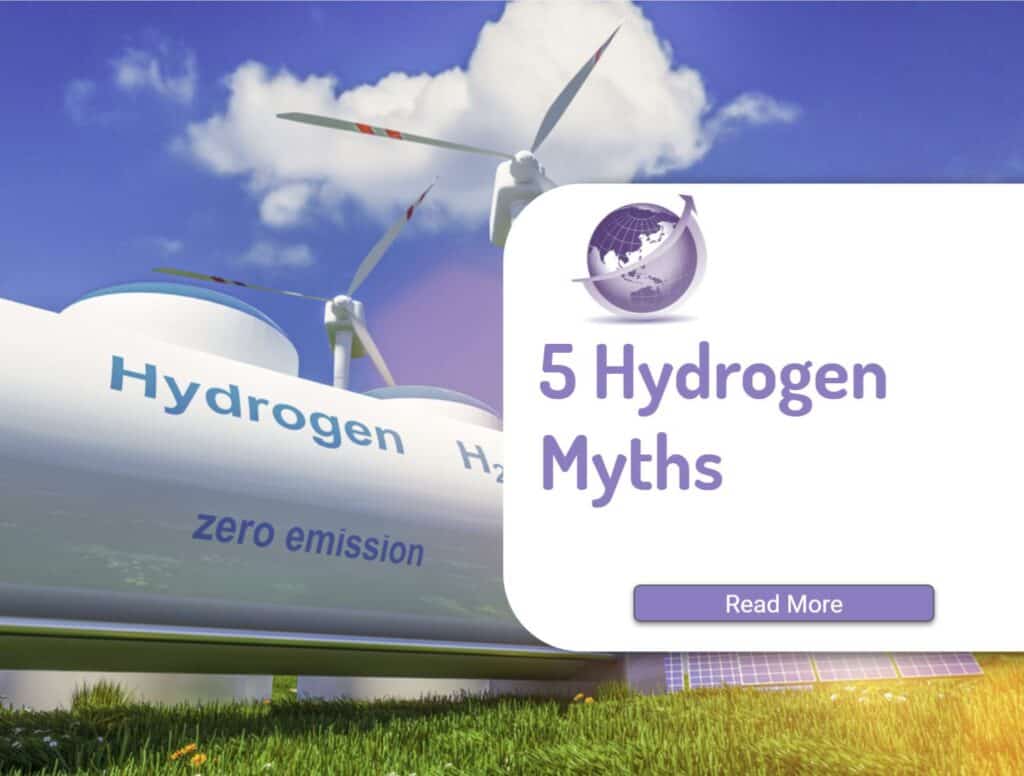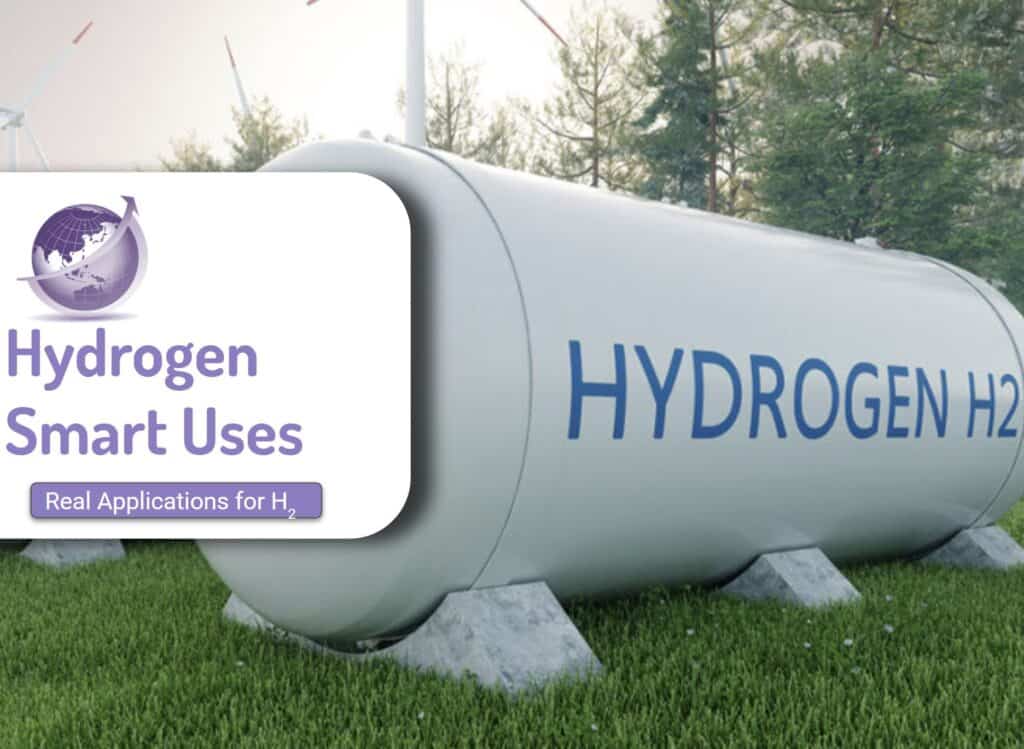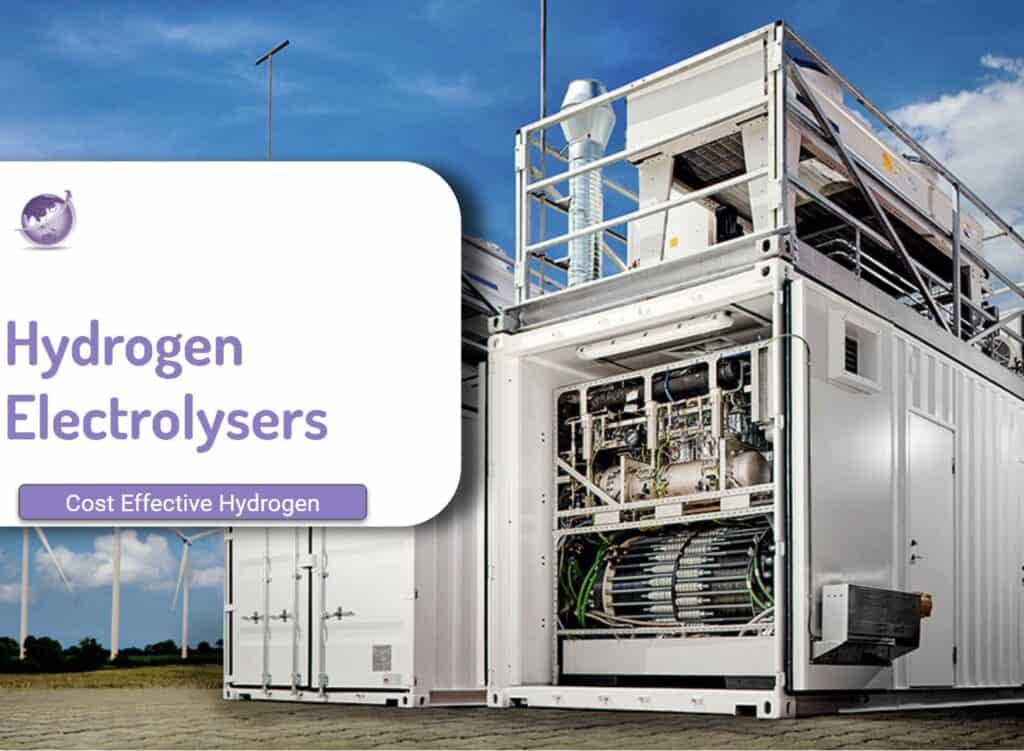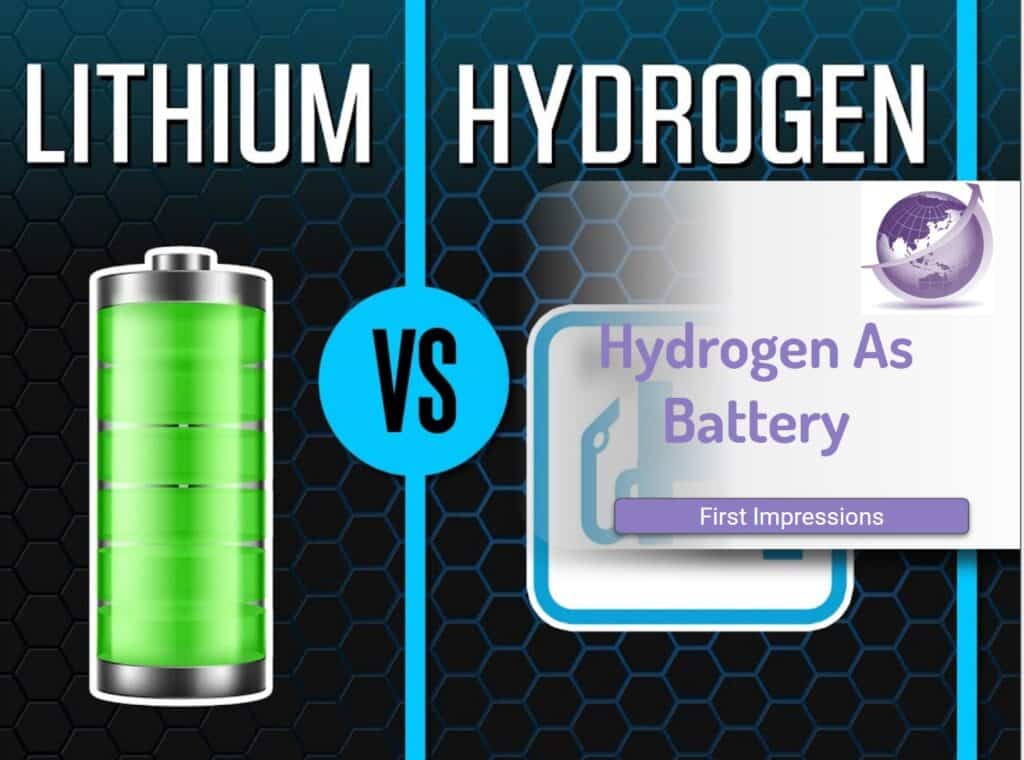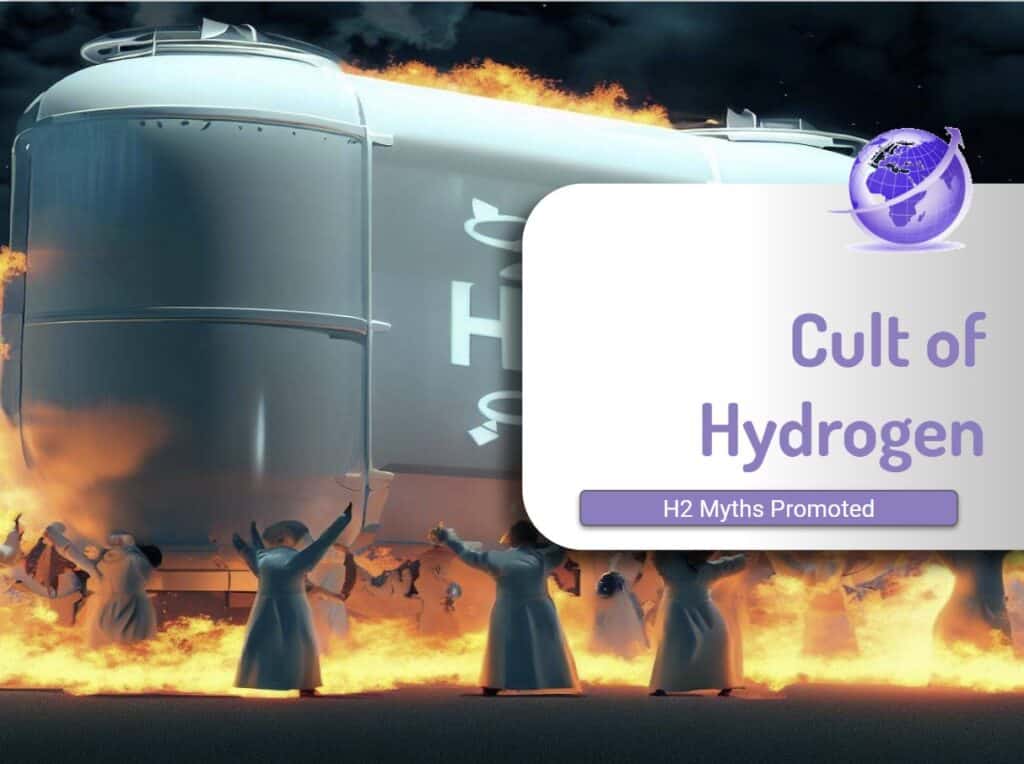What is the carbon intensity of hydrogen for the various colours of hydrogen? I asked Gemini 22-Aug-2025 to research what was the carbon intensity after I had looked at the published data and wanted to explore in more detail. The answer? It depends. Using full life cycle analysis we can see green hydrogen using a fossil fuel powered grid will have high carbon emissions, or a blue H2 can have very bad emissions if methane emissions more than offset the carbon capture and storage removal of CO2.
Executive Summary
The discourse surrounding hydrogen has conventionally relied on a “color-coded” classification system—green, blue, gray, and brown—to denote different production pathways and their associated environmental footprints. However, a detailed analysis reveals that this framework is a gross oversimplification. The carbon intensity of hydrogen is not a static value tied to a specific color but rather a wide-ranging metric, measured in grams of carbon dioxide equivalent per kilogram of hydrogen (gCO2e/kgH2), that is profoundly influenced by a multitude of variables throughout its lifecycle.
A comprehensive lifecycle assessment (LCA) demonstrates that emissions are generated at every stage, from feedstock extraction to the manufacturing of production equipment. The most critical variables include the carbon intensity of the electricity source, the rate of fugitive methane leakage, and the efficiency of carbon capture technologies. For example, a “green” hydrogen project powered by a fossil-heavy electrical grid can have a carbon footprint nearly double that of a benchmark “gray” hydrogen project. Conversely, a high-performance “blue” hydrogen facility with advanced carbon capture can achieve emissions profiles competitive with some forms of green hydrogen.
The following report provides a detailed breakdown of the carbon intensity for each pathway, deconstructing the conventional color narrative and offering a quantitative, data-driven framework for evaluation. The analysis concludes that for hydrogen to fulfill its promise as a decarbonization solution, the industry must transition from qualitative labels to a transparent, verifiable emissions intensity score.
Table 1: Comparative Carbon Intensity Ranges of Hydrogen Production Pathways
| Pathway | Production Method | Carbon Intensity Range (gCO2e/kgH2) | Key Influencing Factors |
| Gray | Steam Methane Reforming (SMR) | 9,000 – 12,000 | Feedstock composition, transportation, and efficiency. |
| Brown | Coal Gasification | ~19,000 | Coal type (bituminous vs. lignite), gasification efficiency. |
| Blue | SMR with Carbon Capture and Storage (CCS) | 800 – >10,000 | Methane leakage rate, carbon capture efficiency, and GWP metric. |
| Green | Water Electrolysis with Renewable Power | <100 – >20,000 | Source of electricity (dedicated vs. grid), electrolyzer efficiency, and embedded emissions. |
1. Introduction: A Critical Look at Hydrogen Carbon Intensity
1.1 The Hydrogen Spectrum: Why “Colors” Are a Misnomer
The rapid expansion of the hydrogen economy has given rise to a popular classification system based on “colors.” Gray hydrogen is produced from natural gas, blue hydrogen adds carbon capture, and green hydrogen is derived from renewable electricity. While this framework provides a simple, accessible way to differentiate production methods, it is fundamentally inadequate for assessing the true environmental impact of a hydrogen project.1
Numerous expert organizations, including the International Energy Agency (IEA) and RMI, have warned that these simple labels “obscure many different levels of potential emissions”.1 A supply of hydrogen with the same “color” can have a vastly different carbon footprint depending on the specific technologies, feedstocks, and supply chain logistics involved.2 For this reason, a quantitative evaluation based on lifecycle emissions intensity is gaining traction as a more robust and honest metric for industry and policy.2 This report will apply this more rigorous approach to analyze each of the four primary pathways.
1.2 Defining the Scope: The Importance of a Lifecycle Assessment (LCA) Approach
To accurately measure the carbon intensity of hydrogen, a “cradle-to-gate” lifecycle assessment (LCA) is essential. This methodology accounts for all greenhouse gas (GHG) emissions from the point of feedstock extraction to the production facility’s gate.2 This goes beyond the direct emissions at the production site to include upstream and midstream emissions from activities such as natural gas drilling, transportation, and electricity generation for the production process.5 For pathways reliant on manufactured equipment, such as electrolyzers or solar panels, the embedded emissions from their production must also be factored in.4 Evaluating hydrogen production without this comprehensive scope leads to an incomplete and misleading picture of its true environmental impact.
1.3 Methodology and Emissions Metrics
Carbon intensity is most accurately expressed in units of carbon dioxide equivalent per kilogram of hydrogen (gCO2e/kgH2). The “equivalent” designation is crucial as it accounts for greenhouse gases other than carbon dioxide, primarily methane (CH4).4 Methane is a far more potent greenhouse gas than carbon dioxide, and its warming potential is a significant factor in the carbon footprint of fossil fuel-based hydrogen.4
The impact of methane is measured using a Global Warming Potential (GWP) metric, which compares the warming effect of a gas to that of carbon dioxide over a specified period. The choice of timeframe for this metric is a point of significant debate in the industry. The 100-year GWP (GWP-100) is a commonly used standard, but the 20-year GWP (GWP-20) assigns a much higher warming potential to methane over a shorter, more immediate timeframe. The IEEFA, for instance, uses a 20-year GWP, which dramatically increases the calculated carbon intensity of blue hydrogen due to methane leakage.8 A complete analysis of hydrogen’s carbon intensity must be transparent about the GWP metric used in its calculations, as this can fundamentally alter the final emissions score.
2. Gray Hydrogen: The Foundational Benchmark
Gray hydrogen is the most prevalent form of hydrogen production today, accounting for an estimated 95% of the global supply.1 It is primarily produced through a process known as Steam Methane Reforming (SMR), where high-temperature steam reacts with natural gas, which is mostly methane (CH4).10
The core reaction is an endothermic process: CH4 + H2O → CO + 3H2. This is followed by a water-gas shift reaction to produce more hydrogen and a significant quantity of carbon dioxide: CO + H2O → CO2 + H2.10 The energy content of the hydrogen produced is approximately 74% of the original fuel’s energy content.10
The carbon intensity of gray hydrogen is a critical benchmark for all other production methods. For every kilogram of hydrogen produced, this process emits approximately 9 to 12 kilograms of carbon dioxide (9,000 to 12,000 gCO2/kgH2).10 The Hydrogen Council specifies an intensity of 11,000 gCO2e/kgH2 for natural gas transported over 5,000 km, demonstrating how factors beyond the production plant’s gate contribute to the final carbon footprint.7 The widespread use of this high-emissions pathway underscores the urgent need for a transition to lower-carbon alternatives.
3. Brown Hydrogen: The High-Carbon Legacy
Brown hydrogen is produced from the gasification of coal, a process that is recognized as one of the most carbon-intensive methods of hydrogen generation.12 The term “brown” sometimes refers specifically to the use of lignite coal, a low-grade coal, while “black” hydrogen refers to the use of higher-grade bituminous coal.12
The process of coal gasification generates significant greenhouse gas emissions. The carbon intensity for brown hydrogen is cited at a high value of approximately 19,000 gCO2/kgH2 (19 tCO2/tH2).12 This figure represents the high end of the emissions spectrum for hydrogen production and serves as a stark illustration of the types of legacy infrastructure that must be phased out to achieve global decarbonization goals.
4. Blue Hydrogen: The Transitional Debate
Blue hydrogen is produced using the same SMR process as gray hydrogen, but it incorporates Carbon Capture and Storage (CCS) technology to capture a portion of the emitted carbon dioxide before it is released into the atmosphere.10 This addition significantly reduces, but does not eliminate, the overall carbon footprint. The carbon intensity of blue hydrogen is at the center of a major policy and scientific debate, with reported values ranging from a low of
800 gCO2e/kgH2 to over 10,000 gCO2e/kgH2.1
The wide range of reported values stems from two primary variables: the rate of fugitive methane leakage during the natural gas supply chain and the efficiency of the carbon capture technology.2 The Hydrogen Council cites a carbon intensity of 1,500 gCO2e/kgH2 for SMR with a 90% capture rate, and as low as 600 gCO2e/kgH2 with a 98% capture rate.7 However, critics argue that these figures are based on overly optimistic assumptions. An analysis by IEEFA suggests that using more realistic assumptions, such as a higher methane leakage rate and a more conservative 85% carbon capture rate, can result in a carbon intensity between 12,000 and 16,000 gCO2e/kgH2, which is significantly higher than some green hydrogen pathways.8
A critical element of this debate is the choice of GWP metric. Reports that use the GWP-20 metric, which attributes a much higher warming potential to methane over a shorter timeframe, will inherently calculate a higher carbon intensity for blue hydrogen compared to reports using the GWP-100 metric.8 For a blue hydrogen project with a 90% capture rate, the carbon intensity is heavily dependent on the upstream methane leakage rate. The debate over blue hydrogen is thus not just a technical one but is rooted in fundamental disagreements over the underlying assumptions used in emissions calculations.
Table 2: Sensitivity of Blue Hydrogen Carbon Intensity to Key Variables
| Carbon Capture Rate | Methane Leakage Rate | GWP Metric | Estimated Carbon Intensity Range (gCO2e/kgH2) |
| 90% | 0.2% (Shell Target) | GWP-100 | ~1,500 |
| 90% | 1.7% (IEA Average) | GWP-100 | ~2,500 |
| 85% | 2.5% (IEEFA Analysis) | GWP-20 | >12,000 |
5. Green Hydrogen: The Low-Carbon Future
Green hydrogen is produced via electrolysis, a process that splits water (H2O) into hydrogen (H2) and oxygen (O2) using electricity.14 For the hydrogen to be considered “green,” this electricity must be generated from entirely renewable sources such as wind, solar, or hydro.14 While the production process itself at the point of use is carbon-free, the lifecycle emissions are not zero.4
The carbon intensity of green hydrogen is determined primarily by the source of the electricity and the “embedded emissions” from the manufacturing of the production equipment.4 The emissions associated with manufacturing wind turbines and solar panels, for example, are a factor in the final carbon intensity score.1 The lowest-emission green hydrogen pathways are achieved with dedicated, low-cost renewable resources like hydropower, with a reported intensity as low as
300 gCO2e/kgH2, followed by wind at approximately 500 gCO2e/kgH2.7
However, the assumption that all green hydrogen is inherently clean is a critical misconception. The carbon intensity can vary dramatically depending on whether the electrolyzer is powered by a dedicated renewable source or connected to an existing electrical grid. An analysis by RMI found that producing hydrogen on a fossil-heavy grid, such as the one in Texas, can result in a carbon intensity of over 20,000 gCO2/kgH2.2 This figure is nearly double the emissions of even gray hydrogen. This finding demonstrates that green hydrogen, when sourced improperly, can be more carbon-intensive than the very fossil fuel-based production it is intended to replace. The reliance on the electricity source means that the carbon intensity of grid-connected electrolysis fluctuates with the grid mix, creating a dynamic emissions profile that cannot be captured by a simple “color” label.2
6. Comparative Analysis and Synthesis
The data presented across the four hydrogen pathways makes it clear that a simple color-coding system is insufficient for project evaluation. The spectrum of carbon intensity is broad and, in some cases, overlapping. For example, a poorly executed “green” project that relies on a carbon-intensive grid can have a higher carbon footprint than a standard “gray” hydrogen project.2 Conversely, a well-managed “blue” hydrogen project with high carbon capture rates can achieve an emissions profile that is competitive with some green hydrogen pathways.7
The average emissions intensity of global hydrogen production today is in the range of 12,000 to 13,000 gCO2e/kgH2, which is dominated by unabated fossil fuels.3 The trajectory to a net-zero future requires this average to fall below 1,000 gCO2e/kgH2 by 2050.16 This goal cannot be achieved without a rigorous, data-driven framework that moves beyond qualitative labels.
The dominant variables influencing carbon intensity are interconnected. Location plays a crucial role, as regions with abundant, low-cost renewable resources have a competitive advantage in producing low-emission hydrogen.6 Similarly, access to a mature, efficient carbon capture and storage infrastructure is a prerequisite for producing genuinely low-carbon blue hydrogen. Finally, the choice of technology, such as the efficiency of the electrolyzer or the type of carbon capture, directly affects the final emissions score.5
A true expert-level assessment of a hydrogen project must adopt a quantitative, lifecycle-based framework that provides a transparent emissions intensity score. This framework should account for feedstock, energy source, transportation, and equipment manufacturing, allowing for a direct and verifiable comparison of different pathways regardless of their “color”.2
7. Strategic Implications and Recommendations
Hydrogen is a critical vector for decarbonizing “hard-to-abate” sectors such as heavy industry, high-heat manufacturing, and long-distance transport, where direct electrification is not a feasible solution.4 The success of this transition, however, is entirely dependent on the ability of the industry to produce truly low-carbon hydrogen. As one expert stated, “If the carbon intensity of the hydrogen is not low enough, its role in decarbonization is zero”.4
Given the significant variability in carbon intensity and the risks of investing in high-emission projects, a clear and actionable strategy is required for all stakeholders.
Recommendations:
- For Policymakers: Governments should move away from regulatory frameworks based on simplistic color definitions and instead establish a technology-agnostic, emissions-intensity standard.3 Incentives and subsidies should be tied directly to a project’s verified lifecycle carbon intensity score, rewarding projects that demonstrably outperform the fossil fuel benchmark.
- For Developers and Investors: A rigorous, transparent lifecycle assessment should be a mandatory component of every project proposal.2 This includes a thorough scrutiny of upstream methane leakage rates for fossil fuel-based projects and a detailed analysis of the electricity source for electrolysis projects. The focus should be on building projects that contribute to grid decarbonization rather than simply drawing power from a carbon-intensive source.2
- For End Users: Consumers and industrial users of hydrogen should demand transparency from suppliers. Contracts should be based on a verified emissions intensity score, allowing for the procurement of hydrogen with the lowest possible carbon footprint, thereby ensuring that the use of hydrogen truly contributes to their decarbonization goals.
Works cited
- The Climate Benefit of a Greener Blue Hydrogen, accessed on August 21, 2025, https://www.energy.gov/sites/default/files/2024-11/h2-emissions-workshop-10-hauglustaine.pdf
- Hydrogen Reality Check: All “Clean Hydrogen” Is Not Equally Clean …, accessed on August 21, 2025, https://rmi.org/all-clean-hydrogen-is-not-equally-clean/
- Executive summary – Towards hydrogen definitions based on their …, accessed on August 21, 2025, https://www.iea.org/reports/towards-hydrogen-definitions-based-on-their-emissions-intensity/executive-summary
- How clean is green hydrogen? | MIT Climate Portal, accessed on August 21, 2025, https://climate.mit.edu/ask-mit/how-clean-green-hydrogen
- www.iea.org, accessed on August 21, 2025, https://www.iea.org/reports/towards-hydrogen-definitions-based-on-their-emissions-intensity/executive-summary#:~:text=The%20fuel%20and%20technology%20used,emissions%20intensity%20of%20hydrogen%20production.
- Towards hydrogen definitions based on their emissions intensity – NET, accessed on August 21, 2025, https://iea.blob.core.windows.net/assets/acc7a642-e42b-4972-8893-2f03bf0bfa03/Towardshydrogendefinitionsbasedontheiremissionsintensity.pdf
- Hydrogen decarbonization pathways – Hydrogen Council, accessed on August 21, 2025, https://hydrogencouncil.com/wp-content/uploads/2021/04/Hydrogen-Council-Report_Decarbonization-Pathways_Part-1-Lifecycle-Assessment.pdf
- Blue Hydrogen: Not Clean, Not Low Carbon, Not a Solution, accessed on August 21, 2025, https://www.energy.gov/sites/default/files/2024-02/090.%20David%20Schlissel%20and%20Anika%20Juhn,%20IEEFA,%20Blue%20Hydrogen%20Not%20Clean%20Not%20Low%20Carbon.pdf
- Response to “How Green is Blue Hydrogen” by Howarth (Stanford …, accessed on August 21, 2025, https://oversightdemocrats.house.gov/sites/evo-subsites/democrats-oversight.house.gov/files/a/shell-documents/SOC-HCOR-404410.pdf
- Hydrogen production – Wikipedia, accessed on August 21, 2025, https://en.wikipedia.org/wiki/Hydrogen_production
- en.wikipedia.org, accessed on August 21, 2025, https://en.wikipedia.org/wiki/Hydrogen_production#:~:text=In%20general%2C%20steam%20reforming%20emits,CH4)%2C%20and%20water.
- The Colors of Hydrogen | The Belfer Center for Science and International Affairs, accessed on August 21, 2025, https://www.belfercenter.org/research-analysis/colors-hydrogen
- www.belfercenter.org, accessed on August 21, 2025, https://www.belfercenter.org/research-analysis/colors-hydrogen#:~:text=Black%20or%20brown%20hydrogen%20refers,tCO2%2FtH2).
- www.linde.com, accessed on August 21, 2025, https://www.linde.com/clean-energy/our-h2-technology/electrolysis-for-green-hydrogen-production#:~:text=Today%2C%20the%20most%20common%20way,in%20units%20known%20as%20electrolyzers.
- Hydrogen Production: Electrolysis | Department of Energy, accessed on August 21, 2025, https://www.energy.gov/eere/fuelcells/hydrogen-production-electrolysis
- www.iea.org, accessed on August 21, 2025, https://www.iea.org/reports/towards-hydrogen-definitions-based-on-their-emissions-intensity/executive-summary#:~:text=The%20average%20emissions%20intensity%20of,kg%20H2%20by%202050.
- IRENA projects Europe as the epicentre of green hydrogen imports: USD 2.49 trillion in global infrastructure investment required, accessed on August 21, 2025, https://strategicenergy.eu/irena-projects-europe-as-the-epicentre-of-green-hydrogen-imports-usd-2-49-trillion-in-global-infrastructure-investment-required/

